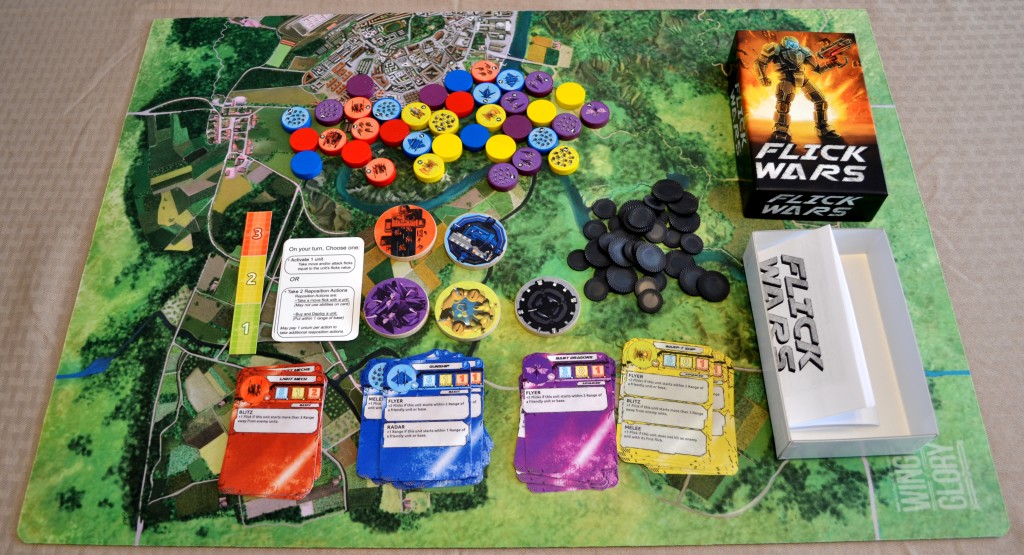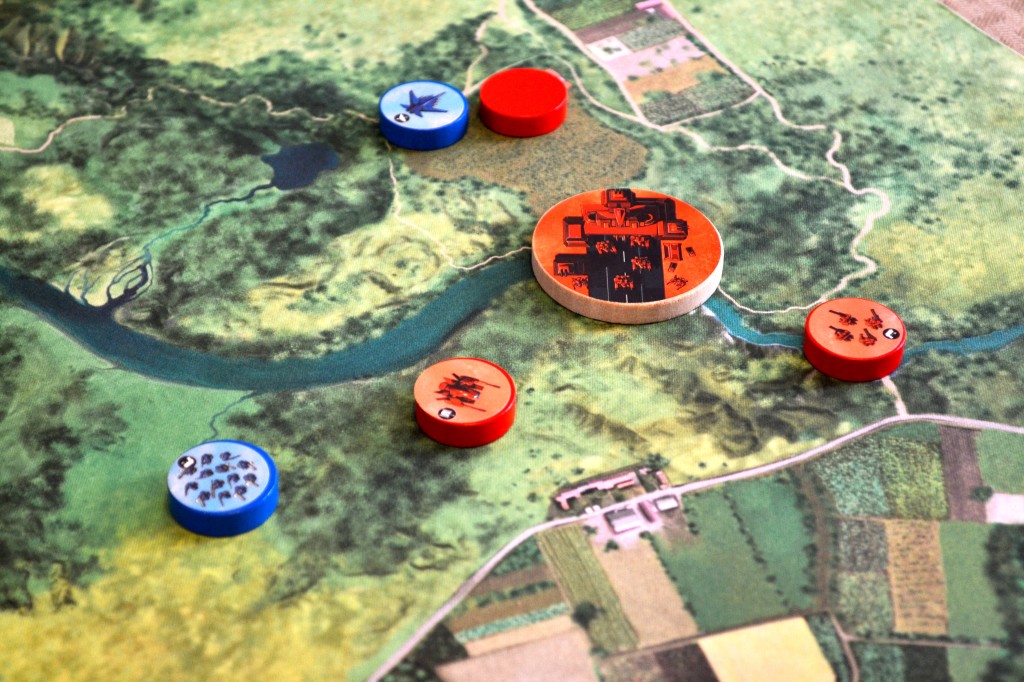I rarely get the chance to play dexterity-based tabletop games, which is a real shame. I find this fact surprisingly odd, seeing as how I’ve played many games in the strategy, simulation, worker placement, casual, and adventure genres. Yet, my play time with dexterity-based games seem to be sporadic at best. “Flick Wars”, a game hitting Kickstarter on April 17, 2014, is unlike anything I’ve played up to this point. I mean, I’ve played my fair share of “Jenga”, but this is vastly different. Using “flicking skills”, players will be tasked with maneuvering their units in such a way that destroys enemy units. The last player left standing, wins the game! Before we take a quick look at what this game has to offer, I’d like to thank Andrew Tullsen from Print & Play Productions for providing me with a prototype copy. It’s important to stress that prototypes are not often reflective of the final components, making everything featured in this article subject to change.
*Editor’s Note: More players are possible if paired into teams.
The components are fairly straight forward. My prototype copy came with a play mat, a range ruler, currency called “unium” in “1” (small chips) and “5” (large chips) denominations, unit cards, unit discs, and large base discs. The play mat will be featured as an add-on in the campaign, I’m told, and will be shipped “rolled up” to prevent any creasing. The range ruler was the most familiar to me, having seen something like it in my “Star Wars: X-Wing Miniatures” and “Star Trek: Attack Wing” games. It’s broken up into three equal sections: “1” (green), “2” (yellow), and “3” (red). The unit cards, unit discs, and large base disc all come in four different colors, representing the four different factions/armies available for players to control. Each player or team will choose a colored set to call their own before launching into game setup.
Setting up the game proved to be as equally simple, though there are a few extra steps/rules to observe when playing with more than two people/teams. There’s also an “advanced” rule set for those who want more in-game options. For the sake of simplicity, I’ll opt to cover the “basic” two player game. The first thing players will do is determine the starting player, which is done via a “skill shot”. Essentially, each player will flick a disc toward the edge of the table…the closest without falling over, wins the contest. Next, players will split the board in half (using their imaginations) and claim half as their own personal territory. Beginning with the starting player, players will place their base “3” range away from their edge of the play mat. At this time, players can add obstacles or terrain pieces using anything they can think of.
Once the board is set up, each player will receive thirty unium and all of their cards labeled as “basic”, placing them nearby. Players can make use of the “advanced” cards for the aforementioned advanced game variant listed in the rulebook if they so choose. Using their starting money, players will secretly buy two unit discs and reveal them all at the same time. They’ll then place those two unit discs within range “1” of their base. Players will find that each unit card is a bit different in terms of cost and other listed stats, giving them some control over what kind of fighting force they’d like to form. You can buy two of the same unit (basic game only), for example, or opt for two different units. I liked that these factions and unit discs weren’t all the same…it made me think a bit about what kind of army would best suit my play style. Defensive players, for example, might want to consider factions and units that have the “shield” and “transport” abilities.
The game is broken up into a series of turns. Players will continue taking turns until the game is over…that is, when a particular player or team is the only one with units left on the table/mat. On a turn, a player can either activate one unit or take two reposition actions…not both. It’s important to note that no one can activate a unit on the very first turn of the game. Taking two reposition actions is probably the easier of the two options, allowing players to take a move flick with a unit or deploy a unit. Additional reposition actions are possible at a cost of one unium per action. Deploying a new unit simply involves paying the cost of the unit and placing it within range “1” of the base, similar to how units were deployed during game setup.
Activating a unit is a bit more complex. The player activating a unit will need to determine how many flicks are possible by looking at its “flicks” value…again, different unit cards have different stats associated with them. Some abilities may even grant some bonus flicks. Each flick is either a move or an attack and it’s important to announce which is being done before you make your attempt. Move flicks allow you to move your unit in any direction you want, though it doesn’t kill enemy units. An attack flick, on the other hand, can kill enemy units by hitting them. Attack flicks can only be done if the defender is within the appropriate range and automatically ends the current player’s turn. Dead units stay on the battlefield flipped over (unless pushed off the table when struck), creating more and more obstacles as the game progresses. I admittedly paraphrased the rulebook a bit and left some things out, but the above should give you a good idea as to how the game is played.
Our play sessions were positive overall. I’ll admit, my inexperience with dexterity-based games in general had me a bit worried about whether or not I could adequately critique this one. With that said, I was very surprised by how easy “Flick Wars” was to pick up and play. Within minutes, Vinnie Jr (13) and I were picking armies and flicking them at one another with semi-wreckless abandon. I’ll go as far as to say that “Flick Wars” would make a great introductory game to the genre as a whole. It’s simplistic in the sense that player turns aren’t bogged down by mountains of options…you’ll either deploy more forces, move, or attack. Yet, the different unit stats and abilities can’t be ignored and will keep you thinking from turn to turn. The advanced rule set will also give players more options as they get used to playing the core game. I really like the fact that objects can be added above or below the mat to change the terrain on a whim, giving you a different experience each time. That feature, just by itself, offers a ton of replayability.
Is “Flick Wars” worth supporting? That depends. Are you a casual gamer family who’s looking to add a bit more zest into game night? Do you like strategy games, but often intrigued by games of dexterity (like “Jenga”)? Did you play a lot of “paper football” in your youth? Are you looking to introduce a friend or family member to the genre? If the answer is yes to any of these questions, then “Flick Wars” may just be what the doctor ordered. At the very least, it’s worth checking out!
Editor’s Note: I briefly covered some of the advanced rules in the video, should you be interested in learning more about them.
—
You can learn more about and support “Flick Wars” by visiting the following websites:
https://www.kickstarter.com/projects/printplaygames/flick-wars
—


